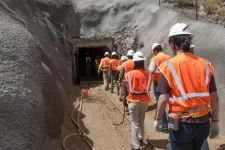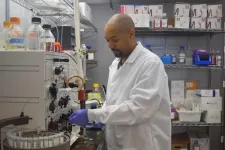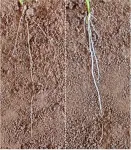(Press-News.org) From mapping ore to predicting slope behavior and reclaiming land, mining is a rapidly evolving technological industry. Yet planning and operations have not necessarily kept up with the advancements.
With $1.25 million from the National Institute for Occupational Safety and Health, or NIOSH, mining and geological engineering researchers in the University of Arizona College of Engineering are boosting their efforts to better align technology and planning for improved safety and productivity.
The award from the institute, part of the Centers for Disease Control and Prevention, will fund the research of six U of A graduate students for the next five years.
"With this award, we are able to train graduate students in important areas and generate cutting-edge research that not only adds to the body of knowledge, but also contributes to the mining industry," said associate professor Angelina Anani, who is leading the project in partnership with professor Moe Momayez and assistant professor Nathalie Risso.
Increasing production at home
The demand for minerals on which technologies such as laptops and electric vehicles are dependent – copper, lithium and cobalt, for example – is at an all-time high. But according to the national Government Accountability Office, the United States is heavily reliant on foreign countries for its supply. By some estimates, more than 80% of the nation's minerals comes from foreign sources.
A renewed federal focus on American-made products and domestic supply chains is challenging the mining industry to increase productivity while continuing to prioritize worker safety.
These NIOSH-funded projects are geared toward improving the entire lifecycle of a mine – from rock assessment to post-mine land use – fundamentally changing how mines are planned and operated, said Anani.
Making better decisions, faster
Anani's group of researchers is investigating dynamic mine planning – a contemporary technique that feeds big data collected during production into artificial intelligence models – providing mine operators with information they need to make better decisions, faster.
"We have not figured out the best way to extract information from that data and apply it to operations in a sustainable way," she said. "Our idea is to take that data and update each stage of the mine planning process by using technologies such as machine learning."
For example, companies could use dynamic mine planning in slope assessments to better predict collapses, which are costly and put workers at risk.
Momayez is using advanced geotechnical methods to evaluate subsurface conditions and map ore deposits.
Presently, mines rely on exploratory boreholes to assess rock condition, but deposits can stretch for miles.
"We're focusing on using geophysical techniques to create a continuous map of geological properties and ore grade before mining," he said, adding that such mapping ties in to dynamically predicting slope behavior.
Aligning automation and safety
Nathalie Risso, director of the university's Mine Automation and Autonomous Systems Laboratory, also is keen on orienting operations to safety regulations and productivity.
"There are a lot of standard operating procedures that are associated with how the mining equipment is supposed to work," she said. "But when you have autonomy, those are not going to apply, so with this research we seek to create new methods to make mining safer and more productive."
The researchers are investigating how autonomous mining vehicles are used in other countries and will provide recommendations for updated regulations in the U.S.
"It is a reimagining of mine planning," said mining doctoral student Tinotenda Blessing Chimbwanda, who is working with Risso and Anani. "Autonomous vehicles bring new risks in terms of how they interact with other equipment.
"The whole idea about mining for me is to make sure that everyone goes home safe and uninjured."
Chimbwanda is one of the graduate students supported by the CDC award; funding is still available for five other students with professors Anani, Risso or Momayez serving as their advisers.
END
CDC awards $1.25M to engineers retooling mine production and safety
2025-01-10
ELSE PRESS RELEASES FROM THIS DATE:
Using AI to uncover hospital patients’ long COVID care needs
2025-01-10
PHILADELPHIA— Across the United States, no hospital is the same. Equipment, staffing, technical capabilities, and patient populations can all differ. So, while the profiles developed for people with common conditions may seem universal, the reality is that there are nuances that require individual attention, both in the make-up of the patients being seen and the situations of the hospitals providing their care.
New research shows that artificial intelligence can potentially help improve care overall by combing through ...
$1.9M NIH grant will allow researchers to explore how copper kills bacteria
2025-01-10
TUCSON, Arizona — A researcher at the University of Arizona College of Medicine – Tucson received a $1.9 million grant from the National Institutes of Health to continue his research into uncovering the mysteries of copper – specifically, how it can be harnessed to kill harmful bacteria and other microorganisms.
“We started using copper tens of thousands of years ago to cut down on bacterial infections,” said Michael D.L. Johnson, PhD, an associate professor ...
New fossil discovery sheds light on the early evolution of animal nervous systems
2025-01-10
Embargoed until Friday 10-Jan-2025 14:00 ET (10-Jan-2025 19:00 GMT/UTC)
An international team of scientists has uncovered a fascinating piece of the evolutionary puzzle: how the ventral nerve cord, a key component of the central nervous system, evolved in ecdysozoan animals, a group that includes insects, nematodes, and priapulid worms. Their findings, published in Science Advances, provide valuable insights into the origins of these structures in the basal Cambrian period.
The research team, comprising Dr Deng Wang (Northwest University), Dr Jean Vannier (Université ...
A battle of rafts: How molecular dynamics in CAR T cells explain their cancer-killing behavior
2025-01-10
HOUSTON – (Jan. 10, 2025) – A study published in Science Advances shares new insights into how two of the most common types of chimeric antigen receptor (CAR) T cells kill cancer. Investigators from Baylor College of Medicine, Texas Children’s Cancer Center and the Center for Cell and Gene Therapy at Baylor, Houston Methodist Hospital and Texas Children’s Hospital examined how molecular dynamics at the immune synapse – where CAR T cells bind to cancer cells – affect anticancer activity.
In this study, researchers aimed to understand how CAR T cells with different signaling domains work at the molecular and cellular levels to lay the ...
Study shows how plant roots access deeper soils in search of water
2025-01-10
Scientists have discovered how plants adapt their root systems in drought conditions to grow steeper into the soil to access deeper water reserves.
Plant scientists from the University of Nottingham, in collaboration with Shanghai Jiao Tong University, have identified how abscisic acid (ABA), a plant hormone known for its role in drought response, influences root growth angles in cereal crops such as rice and maize. The results have been published in Current Biology.
The study highlights how ABA and auxin, another key hormone, work together to shape root growth ...
Study reveals cost differences between Medicare Advantage and traditional Medicare patients in cancer drugs
2025-01-10
A new study examining the use of high-cost drugs among patients with colorectal cancer and non-small cell lung cancer found those insured through Medicare Advantage received less expensive cancer drugs compared to others on Traditional Medicare.
The findings were published today in JAMA Health Forum.
"Lung cancer is the leading cause of cancer-related deaths in the United States and colorectal cancer ranks third. Gaining a better understanding of treatment options and their costs under different insurance plans is important for assessing the overall healthcare landscape and how insurances manage patient costs,” said the study’s first author Cathy Bradley, PhD, Dean ...
‘What is that?’ UCalgary scientists explain white patch that appears near northern lights
2025-01-10
A whitish, grey patch that sometimes appears in the night sky alongside the northern lights has been explained for the first time by researchers at the University of Calgary.
The article, which was published on Dec. 30 in the journal Nature Communications, explores a “structured continuum emission” that’s associated with aurora borealis.
“You’d see this dynamic green aurora, you’d see some of the red aurora in the background and, all of a sudden, you’d see this structured – almost like a patch – grey-toned or white toned-emission connected to the aurora,” says Dr. Emma Spanswick, ...
How many children use Tik Tok against the rules? Most, study finds
2025-01-10
How many children use Tik Tok against the rules? Most, study finds
As the U.S. Supreme Court considers whether Congress can ban Tik Tok, new research highlights the health risks that top social media platforms pose to children.
Most 11- and 12-year-olds use Tik Tok and other social media despite the platforms’ age restrictions, and many show signs of addiction to social media, a new UC San Francisco study found.
Tik Tok, Instagram, YouTube, and Snapchat require users to be at least 13 years old to have an account. But the study found that a majority of 11- and 12-years olds across the country have accounts on the platforms, ...
Scientists find out why aphasia patients lose the ability to talk about the past and future
2025-01-10
An international team of researchers, including scientists from the HSE Centre for Language and Brain, has identified the causes of impairments in expressing grammatical tense in people with aphasia. They discovered that individuals with speech disorders struggle with both forming the concept of time and selecting the correct verb tense. However, which of these processes proves more challenging depends on the speaker's language. The findings have been published in the journal Aphasiology.
Aphasia is a severe speech disorder, often resulting ...
Tickling the nerves: Why crime content is popular
2025-01-10
Consumers of content about serial killers watch and read it to experience intense emotions that are often lacking in everyday life and to understand the reasons that drive people to commit crimes. However, such content does not contribute to increased aggression. These conclusions were drawn by sociologists from HSE University. The results of their study have been published in Crime, Media, Culture: An International Journal.
Research on the modern media market shows that content about serial killers is popular worldwide, spanning films, true crime series, short videos, and written materials detailing crimes, investigations, ...



